EBP Proposal: Refining a Nursing Concern Using Research Data Analysis
VerifiedAdded on 2023/06/03
|18
|4480
|300
Report
AI Summary
This report presents a student's proposal for refining a nursing concern into an Evidence-Based Practice (EBP) framework, specifically addressing the concern of ADHD in school-aged children. The proposal outlines comprehensive data collection strategies, employing both quantitative and qualitative methods. The quantitative approach involves questionnaires, biophysiologic measures, self-reports, and structured observations to gather numerical data for statistical analysis, focusing on non-pharmacological therapies. The qualitative approach utilizes observations, artifacts, and interviews to capture respondents' views and perceptions. Data will be collected from various medical and educational facilities over a six-month period. The report details methods for enhancing data quality, including data profiling and normalization for quantitative data, and semantic metadata management and data quality firewalls for qualitative data. The analysis section describes the use of descriptive and inferential statistics, including ANOVA, for quantitative data, and thematic analysis and coding for qualitative data. The proposal emphasizes the importance of data organization and the use of triangulation to ensure the validity and reliability of the research findings, ultimately contributing to the development of effective EBP interventions.
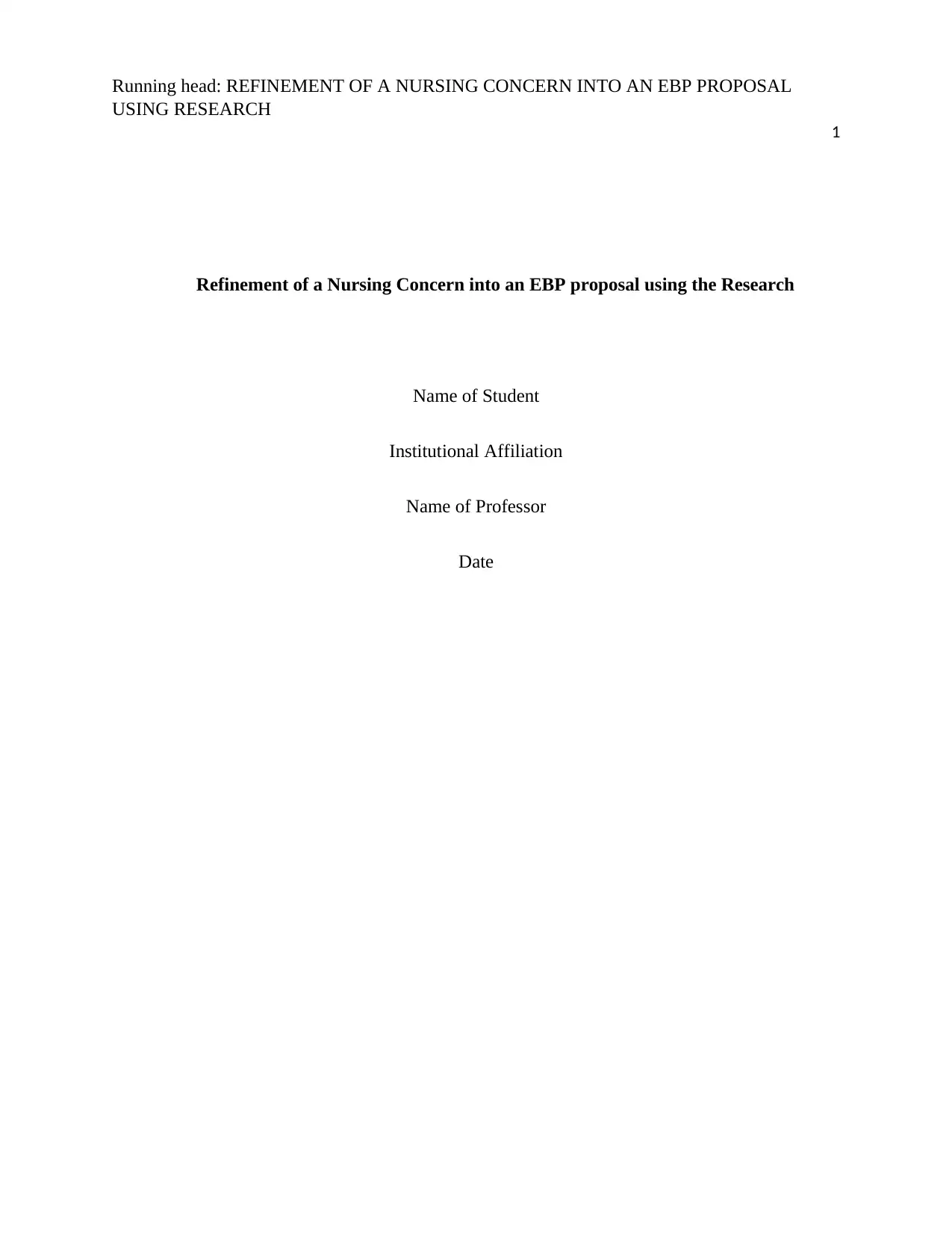
Running head: REFINEMENT OF A NURSING CONCERN INTO AN EBP PROPOSAL
USING RESEARCH
1
Refinement of a Nursing Concern into an EBP proposal using the Research
Name of Student
Institutional Affiliation
Name of Professor
Date
USING RESEARCH
1
Refinement of a Nursing Concern into an EBP proposal using the Research
Name of Student
Institutional Affiliation
Name of Professor
Date
Paraphrase This Document
Need a fresh take? Get an instant paraphrase of this document with our AI Paraphraser
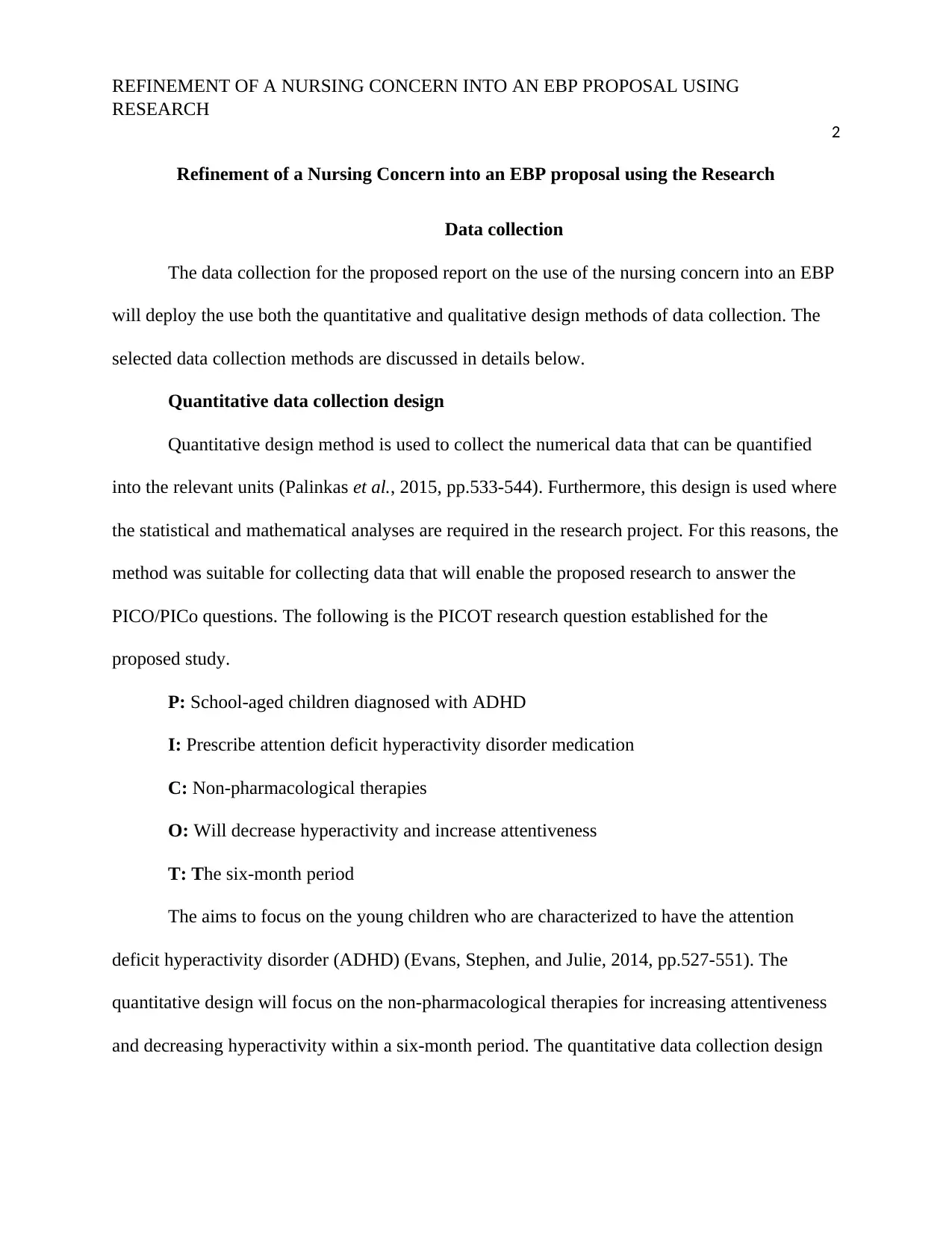
REFINEMENT OF A NURSING CONCERN INTO AN EBP PROPOSAL USING
RESEARCH
2
Refinement of a Nursing Concern into an EBP proposal using the Research
Data collection
The data collection for the proposed report on the use of the nursing concern into an EBP
will deploy the use both the quantitative and qualitative design methods of data collection. The
selected data collection methods are discussed in details below.
Quantitative data collection design
Quantitative design method is used to collect the numerical data that can be quantified
into the relevant units (Palinkas et al., 2015, pp.533-544). Furthermore, this design is used where
the statistical and mathematical analyses are required in the research project. For this reasons, the
method was suitable for collecting data that will enable the proposed research to answer the
PICO/PICo questions. The following is the PICOT research question established for the
proposed study.
P: School-aged children diagnosed with ADHD
I: Prescribe attention deficit hyperactivity disorder medication
C: Non-pharmacological therapies
O: Will decrease hyperactivity and increase attentiveness
T: The six-month period
The aims to focus on the young children who are characterized to have the attention
deficit hyperactivity disorder (ADHD) (Evans, Stephen, and Julie, 2014, pp.527-551). The
quantitative design will focus on the non-pharmacological therapies for increasing attentiveness
and decreasing hyperactivity within a six-month period. The quantitative data collection design
RESEARCH
2
Refinement of a Nursing Concern into an EBP proposal using the Research
Data collection
The data collection for the proposed report on the use of the nursing concern into an EBP
will deploy the use both the quantitative and qualitative design methods of data collection. The
selected data collection methods are discussed in details below.
Quantitative data collection design
Quantitative design method is used to collect the numerical data that can be quantified
into the relevant units (Palinkas et al., 2015, pp.533-544). Furthermore, this design is used where
the statistical and mathematical analyses are required in the research project. For this reasons, the
method was suitable for collecting data that will enable the proposed research to answer the
PICO/PICo questions. The following is the PICOT research question established for the
proposed study.
P: School-aged children diagnosed with ADHD
I: Prescribe attention deficit hyperactivity disorder medication
C: Non-pharmacological therapies
O: Will decrease hyperactivity and increase attentiveness
T: The six-month period
The aims to focus on the young children who are characterized to have the attention
deficit hyperactivity disorder (ADHD) (Evans, Stephen, and Julie, 2014, pp.527-551). The
quantitative design will focus on the non-pharmacological therapies for increasing attentiveness
and decreasing hyperactivity within a six-month period. The quantitative data collection design
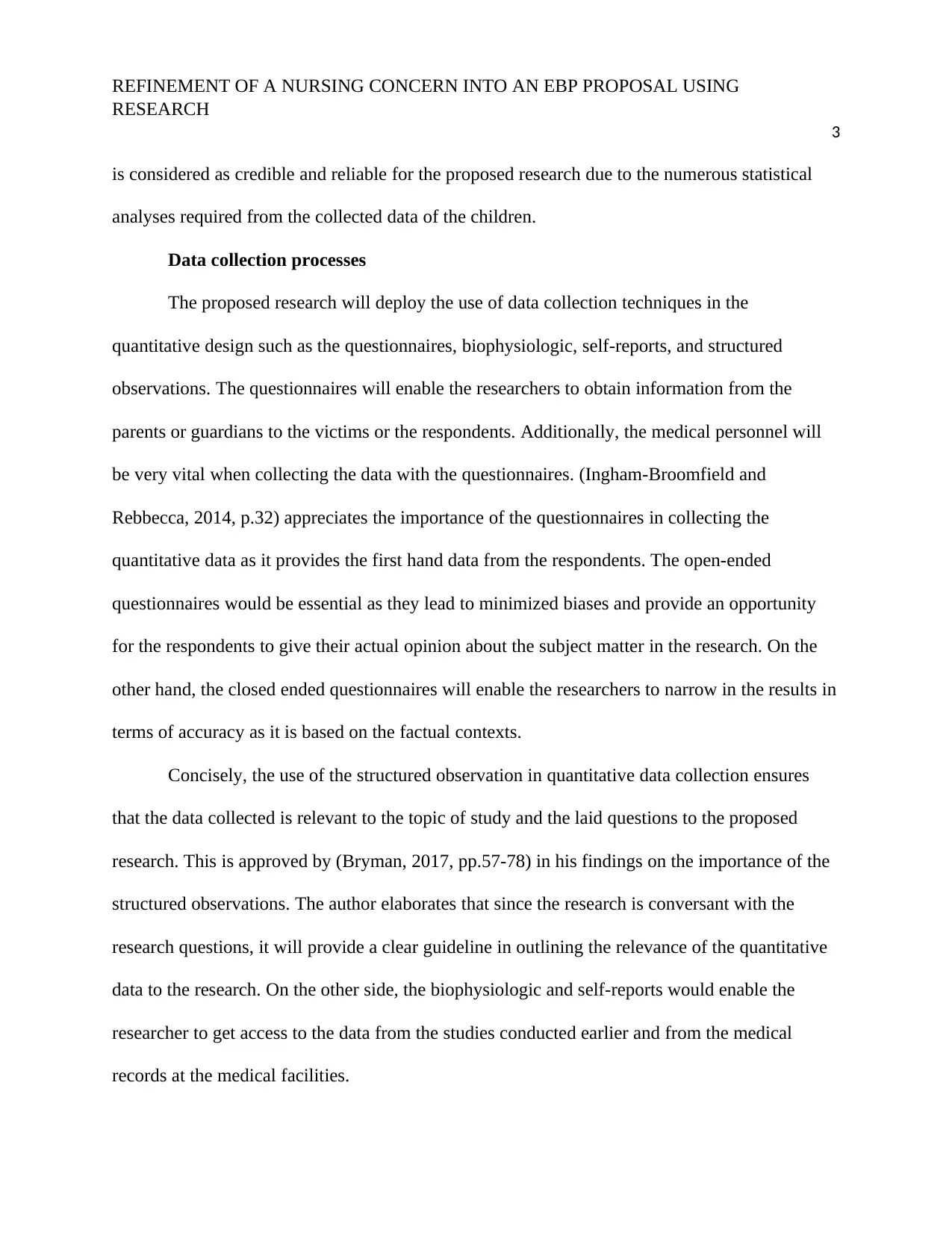
REFINEMENT OF A NURSING CONCERN INTO AN EBP PROPOSAL USING
RESEARCH
3
is considered as credible and reliable for the proposed research due to the numerous statistical
analyses required from the collected data of the children.
Data collection processes
The proposed research will deploy the use of data collection techniques in the
quantitative design such as the questionnaires, biophysiologic, self-reports, and structured
observations. The questionnaires will enable the researchers to obtain information from the
parents or guardians to the victims or the respondents. Additionally, the medical personnel will
be very vital when collecting the data with the questionnaires. (Ingham-Broomfield and
Rebbecca, 2014, p.32) appreciates the importance of the questionnaires in collecting the
quantitative data as it provides the first hand data from the respondents. The open-ended
questionnaires would be essential as they lead to minimized biases and provide an opportunity
for the respondents to give their actual opinion about the subject matter in the research. On the
other hand, the closed ended questionnaires will enable the researchers to narrow in the results in
terms of accuracy as it is based on the factual contexts.
Concisely, the use of the structured observation in quantitative data collection ensures
that the data collected is relevant to the topic of study and the laid questions to the proposed
research. This is approved by (Bryman, 2017, pp.57-78) in his findings on the importance of the
structured observations. The author elaborates that since the research is conversant with the
research questions, it will provide a clear guideline in outlining the relevance of the quantitative
data to the research. On the other side, the biophysiologic and self-reports would enable the
researcher to get access to the data from the studies conducted earlier and from the medical
records at the medical facilities.
RESEARCH
3
is considered as credible and reliable for the proposed research due to the numerous statistical
analyses required from the collected data of the children.
Data collection processes
The proposed research will deploy the use of data collection techniques in the
quantitative design such as the questionnaires, biophysiologic, self-reports, and structured
observations. The questionnaires will enable the researchers to obtain information from the
parents or guardians to the victims or the respondents. Additionally, the medical personnel will
be very vital when collecting the data with the questionnaires. (Ingham-Broomfield and
Rebbecca, 2014, p.32) appreciates the importance of the questionnaires in collecting the
quantitative data as it provides the first hand data from the respondents. The open-ended
questionnaires would be essential as they lead to minimized biases and provide an opportunity
for the respondents to give their actual opinion about the subject matter in the research. On the
other hand, the closed ended questionnaires will enable the researchers to narrow in the results in
terms of accuracy as it is based on the factual contexts.
Concisely, the use of the structured observation in quantitative data collection ensures
that the data collected is relevant to the topic of study and the laid questions to the proposed
research. This is approved by (Bryman, 2017, pp.57-78) in his findings on the importance of the
structured observations. The author elaborates that since the research is conversant with the
research questions, it will provide a clear guideline in outlining the relevance of the quantitative
data to the research. On the other side, the biophysiologic and self-reports would enable the
researcher to get access to the data from the studies conducted earlier and from the medical
records at the medical facilities.
⊘ This is a preview!⊘
Do you want full access?
Subscribe today to unlock all pages.

Trusted by 1+ million students worldwide
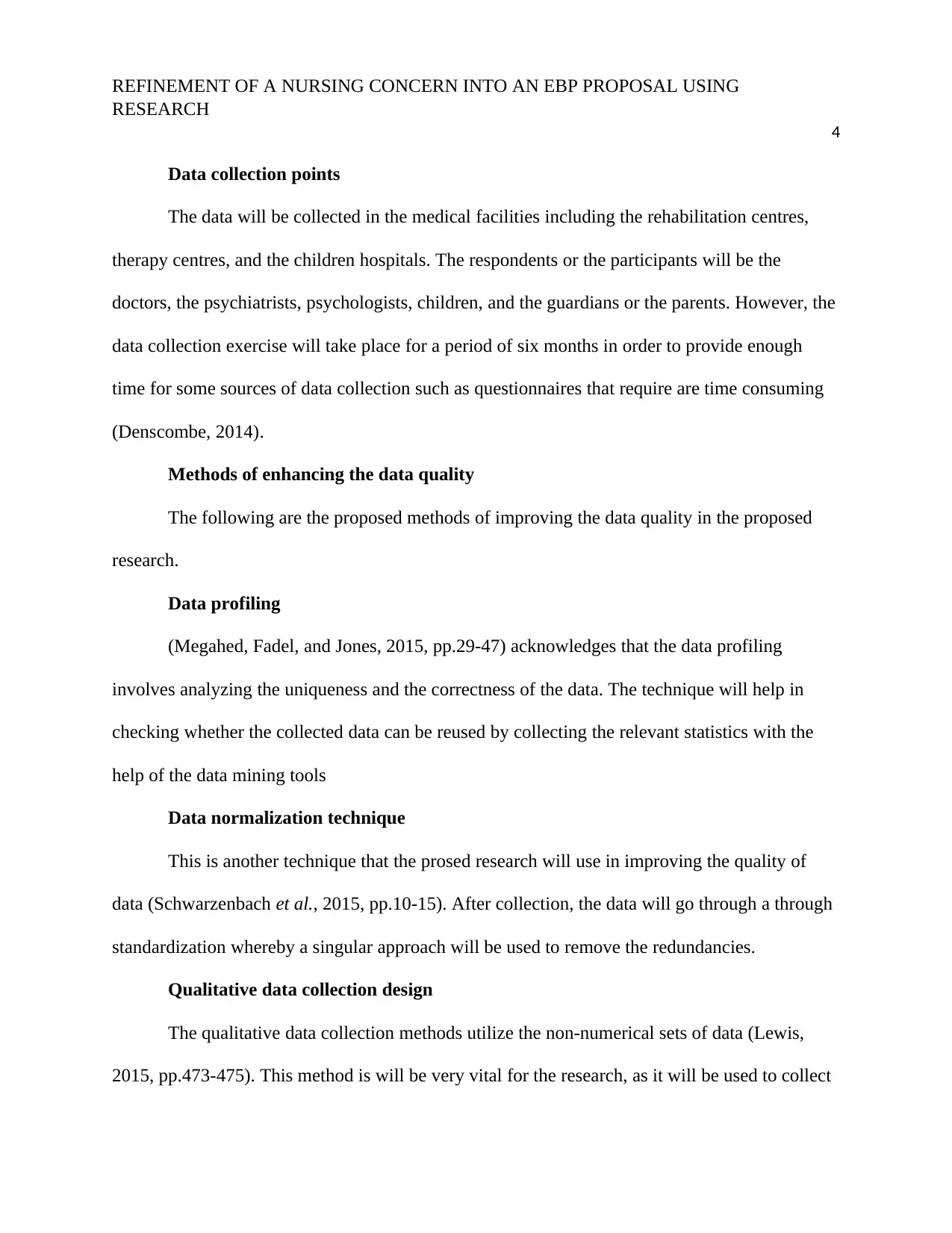
REFINEMENT OF A NURSING CONCERN INTO AN EBP PROPOSAL USING
RESEARCH
4
Data collection points
The data will be collected in the medical facilities including the rehabilitation centres,
therapy centres, and the children hospitals. The respondents or the participants will be the
doctors, the psychiatrists, psychologists, children, and the guardians or the parents. However, the
data collection exercise will take place for a period of six months in order to provide enough
time for some sources of data collection such as questionnaires that require are time consuming
(Denscombe, 2014).
Methods of enhancing the data quality
The following are the proposed methods of improving the data quality in the proposed
research.
Data profiling
(Megahed, Fadel, and Jones, 2015, pp.29-47) acknowledges that the data profiling
involves analyzing the uniqueness and the correctness of the data. The technique will help in
checking whether the collected data can be reused by collecting the relevant statistics with the
help of the data mining tools
Data normalization technique
This is another technique that the prosed research will use in improving the quality of
data (Schwarzenbach et al., 2015, pp.10-15). After collection, the data will go through a through
standardization whereby a singular approach will be used to remove the redundancies.
Qualitative data collection design
The qualitative data collection methods utilize the non-numerical sets of data (Lewis,
2015, pp.473-475). This method is will be very vital for the research, as it will be used to collect
RESEARCH
4
Data collection points
The data will be collected in the medical facilities including the rehabilitation centres,
therapy centres, and the children hospitals. The respondents or the participants will be the
doctors, the psychiatrists, psychologists, children, and the guardians or the parents. However, the
data collection exercise will take place for a period of six months in order to provide enough
time for some sources of data collection such as questionnaires that require are time consuming
(Denscombe, 2014).
Methods of enhancing the data quality
The following are the proposed methods of improving the data quality in the proposed
research.
Data profiling
(Megahed, Fadel, and Jones, 2015, pp.29-47) acknowledges that the data profiling
involves analyzing the uniqueness and the correctness of the data. The technique will help in
checking whether the collected data can be reused by collecting the relevant statistics with the
help of the data mining tools
Data normalization technique
This is another technique that the prosed research will use in improving the quality of
data (Schwarzenbach et al., 2015, pp.10-15). After collection, the data will go through a through
standardization whereby a singular approach will be used to remove the redundancies.
Qualitative data collection design
The qualitative data collection methods utilize the non-numerical sets of data (Lewis,
2015, pp.473-475). This method is will be very vital for the research, as it will be used to collect
Paraphrase This Document
Need a fresh take? Get an instant paraphrase of this document with our AI Paraphraser
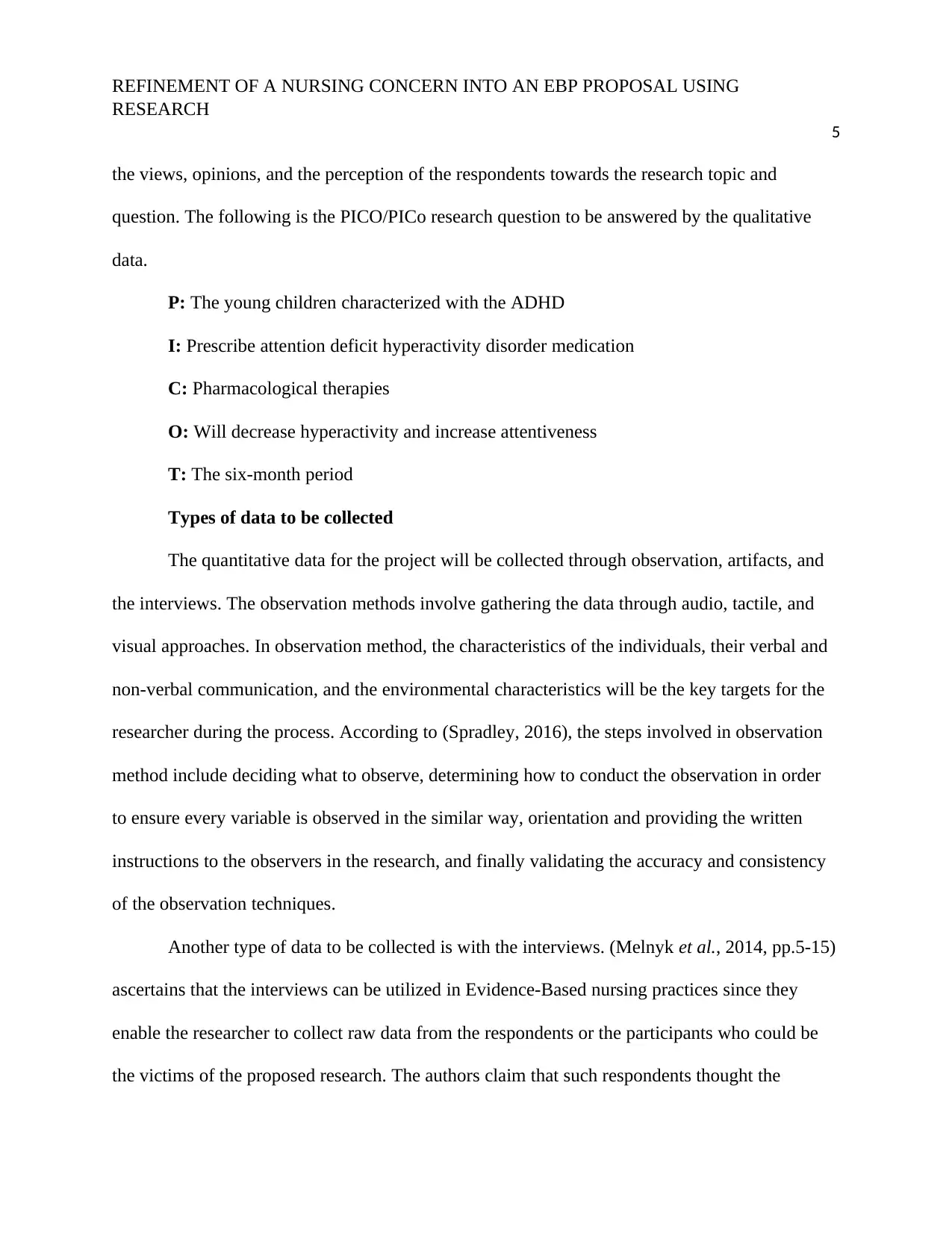
REFINEMENT OF A NURSING CONCERN INTO AN EBP PROPOSAL USING
RESEARCH
5
the views, opinions, and the perception of the respondents towards the research topic and
question. The following is the PICO/PICo research question to be answered by the qualitative
data.
P: The young children characterized with the ADHD
I: Prescribe attention deficit hyperactivity disorder medication
C: Pharmacological therapies
O: Will decrease hyperactivity and increase attentiveness
T: The six-month period
Types of data to be collected
The quantitative data for the project will be collected through observation, artifacts, and
the interviews. The observation methods involve gathering the data through audio, tactile, and
visual approaches. In observation method, the characteristics of the individuals, their verbal and
non-verbal communication, and the environmental characteristics will be the key targets for the
researcher during the process. According to (Spradley, 2016), the steps involved in observation
method include deciding what to observe, determining how to conduct the observation in order
to ensure every variable is observed in the similar way, orientation and providing the written
instructions to the observers in the research, and finally validating the accuracy and consistency
of the observation techniques.
Another type of data to be collected is with the interviews. (Melnyk et al., 2014, pp.5-15)
ascertains that the interviews can be utilized in Evidence-Based nursing practices since they
enable the researcher to collect raw data from the respondents or the participants who could be
the victims of the proposed research. The authors claim that such respondents thought the
RESEARCH
5
the views, opinions, and the perception of the respondents towards the research topic and
question. The following is the PICO/PICo research question to be answered by the qualitative
data.
P: The young children characterized with the ADHD
I: Prescribe attention deficit hyperactivity disorder medication
C: Pharmacological therapies
O: Will decrease hyperactivity and increase attentiveness
T: The six-month period
Types of data to be collected
The quantitative data for the project will be collected through observation, artifacts, and
the interviews. The observation methods involve gathering the data through audio, tactile, and
visual approaches. In observation method, the characteristics of the individuals, their verbal and
non-verbal communication, and the environmental characteristics will be the key targets for the
researcher during the process. According to (Spradley, 2016), the steps involved in observation
method include deciding what to observe, determining how to conduct the observation in order
to ensure every variable is observed in the similar way, orientation and providing the written
instructions to the observers in the research, and finally validating the accuracy and consistency
of the observation techniques.
Another type of data to be collected is with the interviews. (Melnyk et al., 2014, pp.5-15)
ascertains that the interviews can be utilized in Evidence-Based nursing practices since they
enable the researcher to collect raw data from the respondents or the participants who could be
the victims of the proposed research. The authors claim that such respondents thought the
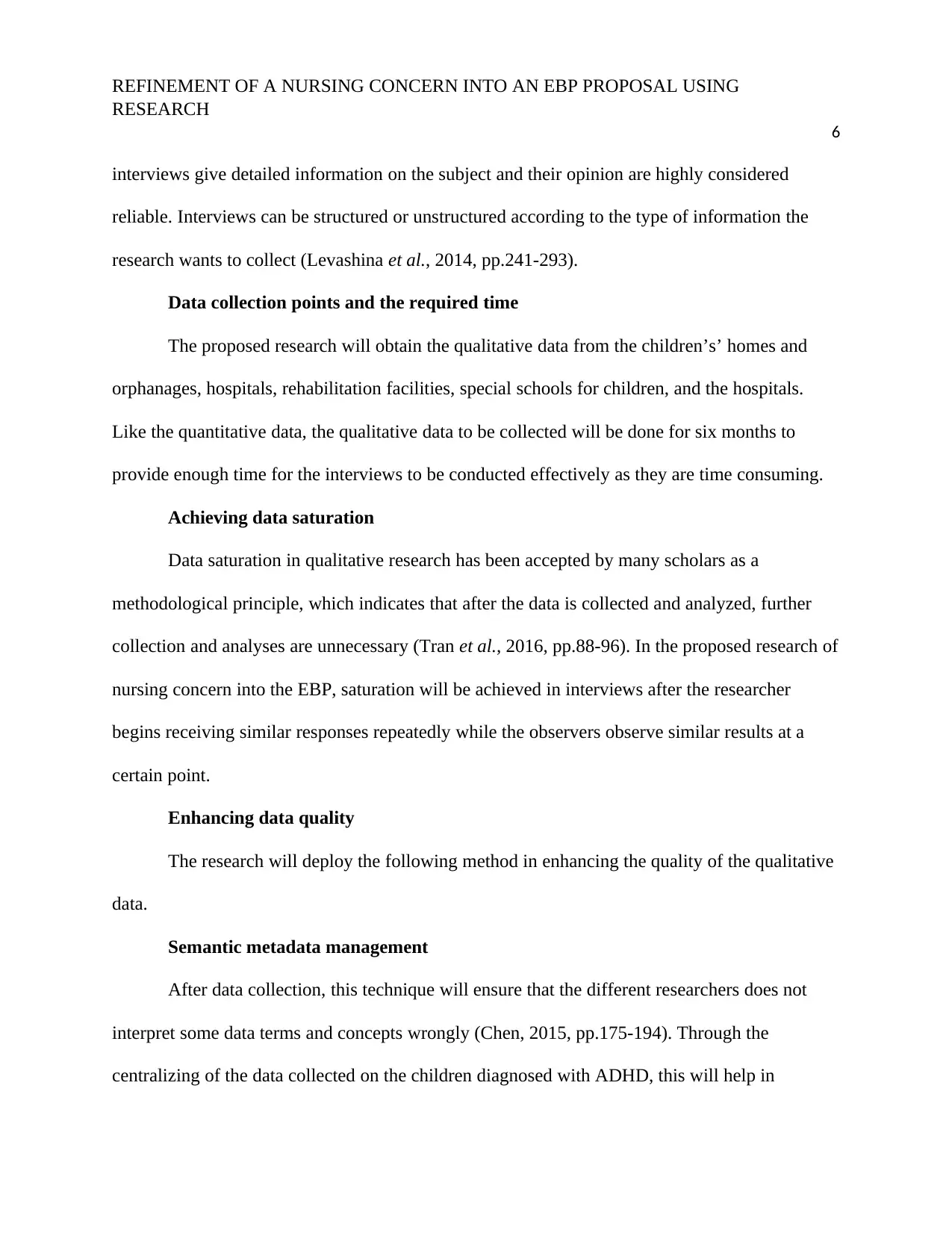
REFINEMENT OF A NURSING CONCERN INTO AN EBP PROPOSAL USING
RESEARCH
6
interviews give detailed information on the subject and their opinion are highly considered
reliable. Interviews can be structured or unstructured according to the type of information the
research wants to collect (Levashina et al., 2014, pp.241-293).
Data collection points and the required time
The proposed research will obtain the qualitative data from the children’s’ homes and
orphanages, hospitals, rehabilitation facilities, special schools for children, and the hospitals.
Like the quantitative data, the qualitative data to be collected will be done for six months to
provide enough time for the interviews to be conducted effectively as they are time consuming.
Achieving data saturation
Data saturation in qualitative research has been accepted by many scholars as a
methodological principle, which indicates that after the data is collected and analyzed, further
collection and analyses are unnecessary (Tran et al., 2016, pp.88-96). In the proposed research of
nursing concern into the EBP, saturation will be achieved in interviews after the researcher
begins receiving similar responses repeatedly while the observers observe similar results at a
certain point.
Enhancing data quality
The research will deploy the following method in enhancing the quality of the qualitative
data.
Semantic metadata management
After data collection, this technique will ensure that the different researchers does not
interpret some data terms and concepts wrongly (Chen, 2015, pp.175-194). Through the
centralizing of the data collected on the children diagnosed with ADHD, this will help in
RESEARCH
6
interviews give detailed information on the subject and their opinion are highly considered
reliable. Interviews can be structured or unstructured according to the type of information the
research wants to collect (Levashina et al., 2014, pp.241-293).
Data collection points and the required time
The proposed research will obtain the qualitative data from the children’s’ homes and
orphanages, hospitals, rehabilitation facilities, special schools for children, and the hospitals.
Like the quantitative data, the qualitative data to be collected will be done for six months to
provide enough time for the interviews to be conducted effectively as they are time consuming.
Achieving data saturation
Data saturation in qualitative research has been accepted by many scholars as a
methodological principle, which indicates that after the data is collected and analyzed, further
collection and analyses are unnecessary (Tran et al., 2016, pp.88-96). In the proposed research of
nursing concern into the EBP, saturation will be achieved in interviews after the researcher
begins receiving similar responses repeatedly while the observers observe similar results at a
certain point.
Enhancing data quality
The research will deploy the following method in enhancing the quality of the qualitative
data.
Semantic metadata management
After data collection, this technique will ensure that the different researchers does not
interpret some data terms and concepts wrongly (Chen, 2015, pp.175-194). Through the
centralizing of the data collected on the children diagnosed with ADHD, this will help in
⊘ This is a preview!⊘
Do you want full access?
Subscribe today to unlock all pages.

Trusted by 1+ million students worldwide
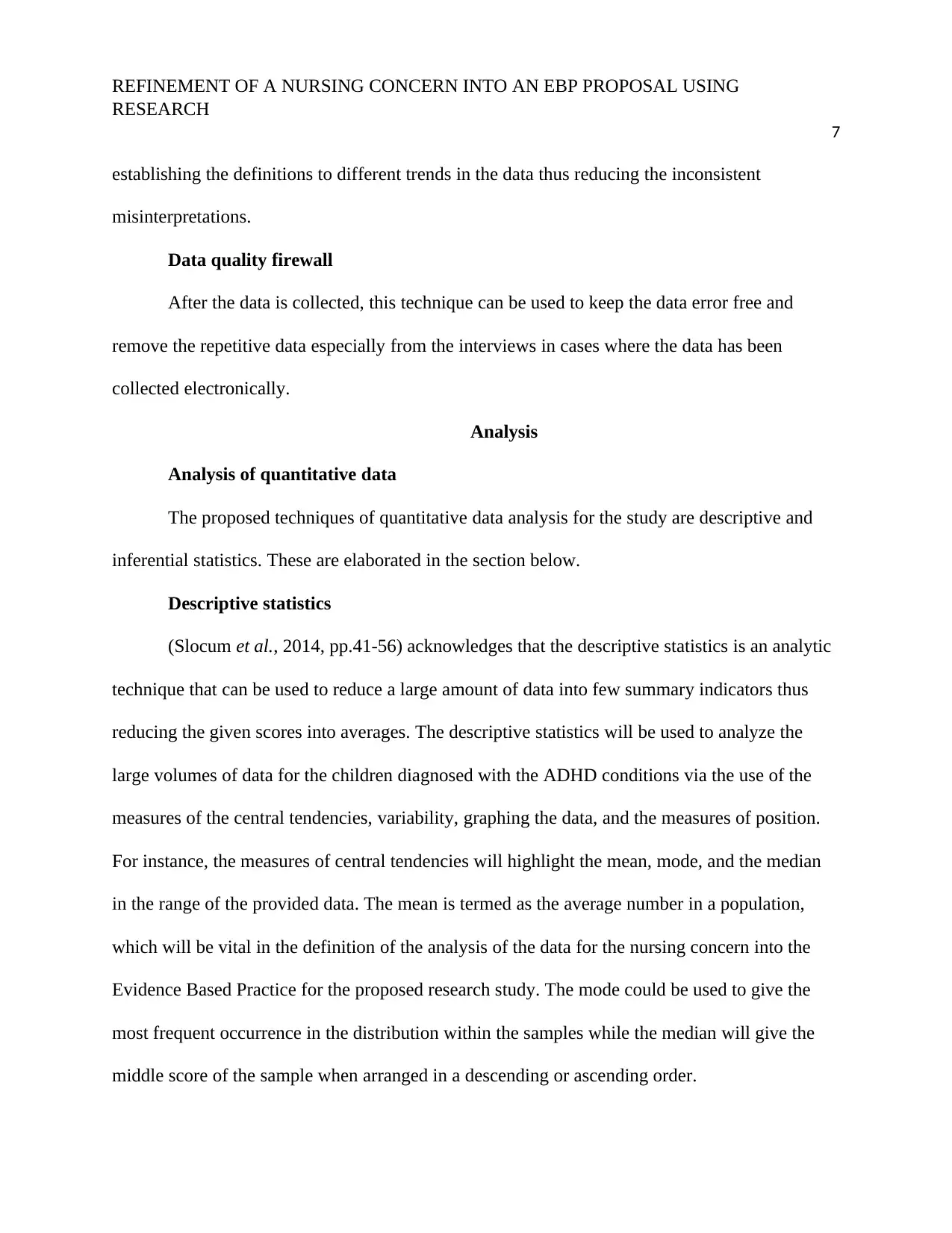
REFINEMENT OF A NURSING CONCERN INTO AN EBP PROPOSAL USING
RESEARCH
7
establishing the definitions to different trends in the data thus reducing the inconsistent
misinterpretations.
Data quality firewall
After the data is collected, this technique can be used to keep the data error free and
remove the repetitive data especially from the interviews in cases where the data has been
collected electronically.
Analysis
Analysis of quantitative data
The proposed techniques of quantitative data analysis for the study are descriptive and
inferential statistics. These are elaborated in the section below.
Descriptive statistics
(Slocum et al., 2014, pp.41-56) acknowledges that the descriptive statistics is an analytic
technique that can be used to reduce a large amount of data into few summary indicators thus
reducing the given scores into averages. The descriptive statistics will be used to analyze the
large volumes of data for the children diagnosed with the ADHD conditions via the use of the
measures of the central tendencies, variability, graphing the data, and the measures of position.
For instance, the measures of central tendencies will highlight the mean, mode, and the median
in the range of the provided data. The mean is termed as the average number in a population,
which will be vital in the definition of the analysis of the data for the nursing concern into the
Evidence Based Practice for the proposed research study. The mode could be used to give the
most frequent occurrence in the distribution within the samples while the median will give the
middle score of the sample when arranged in a descending or ascending order.
RESEARCH
7
establishing the definitions to different trends in the data thus reducing the inconsistent
misinterpretations.
Data quality firewall
After the data is collected, this technique can be used to keep the data error free and
remove the repetitive data especially from the interviews in cases where the data has been
collected electronically.
Analysis
Analysis of quantitative data
The proposed techniques of quantitative data analysis for the study are descriptive and
inferential statistics. These are elaborated in the section below.
Descriptive statistics
(Slocum et al., 2014, pp.41-56) acknowledges that the descriptive statistics is an analytic
technique that can be used to reduce a large amount of data into few summary indicators thus
reducing the given scores into averages. The descriptive statistics will be used to analyze the
large volumes of data for the children diagnosed with the ADHD conditions via the use of the
measures of the central tendencies, variability, graphing the data, and the measures of position.
For instance, the measures of central tendencies will highlight the mean, mode, and the median
in the range of the provided data. The mean is termed as the average number in a population,
which will be vital in the definition of the analysis of the data for the nursing concern into the
Evidence Based Practice for the proposed research study. The mode could be used to give the
most frequent occurrence in the distribution within the samples while the median will give the
middle score of the sample when arranged in a descending or ascending order.
Paraphrase This Document
Need a fresh take? Get an instant paraphrase of this document with our AI Paraphraser
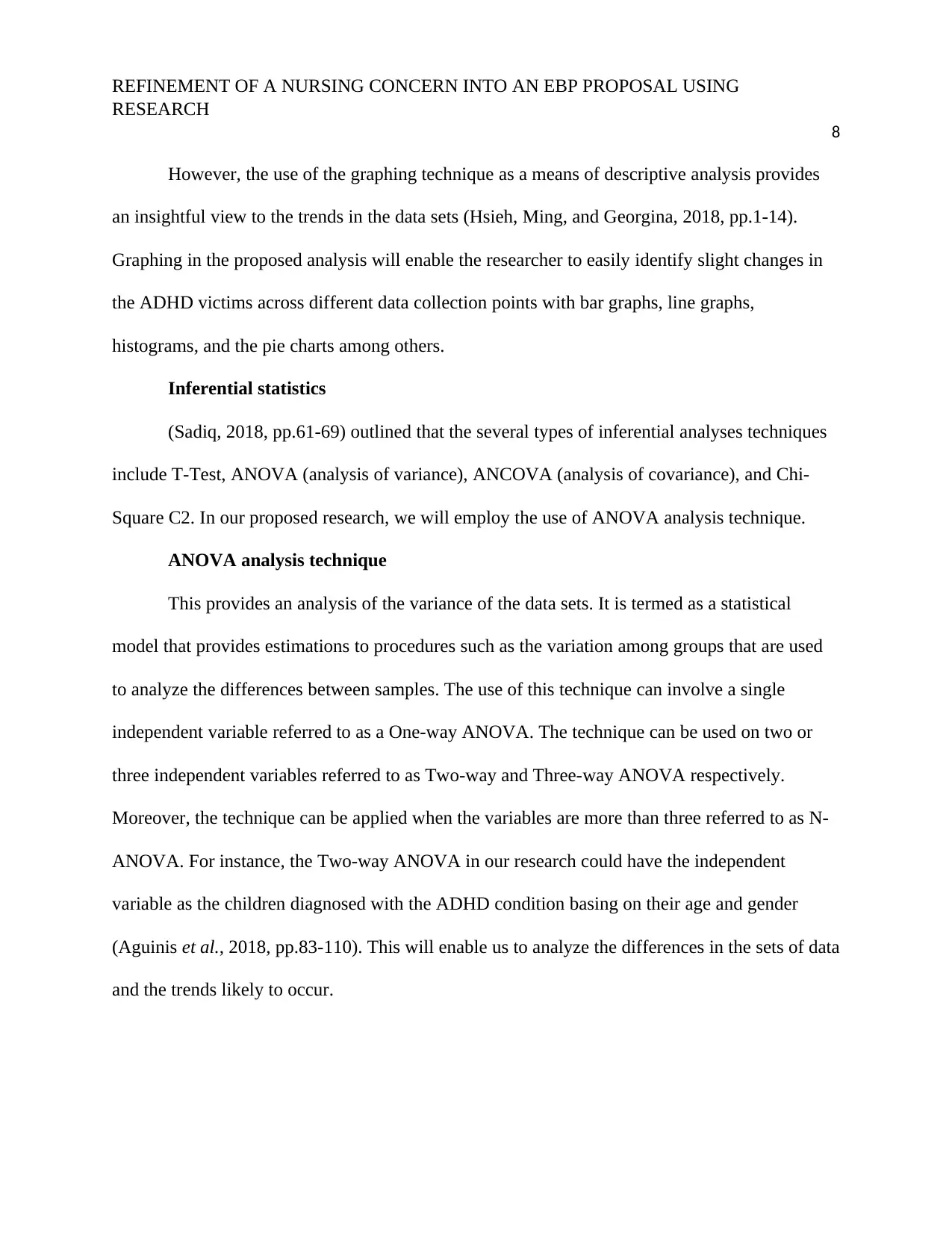
REFINEMENT OF A NURSING CONCERN INTO AN EBP PROPOSAL USING
RESEARCH
8
However, the use of the graphing technique as a means of descriptive analysis provides
an insightful view to the trends in the data sets (Hsieh, Ming, and Georgina, 2018, pp.1-14).
Graphing in the proposed analysis will enable the researcher to easily identify slight changes in
the ADHD victims across different data collection points with bar graphs, line graphs,
histograms, and the pie charts among others.
Inferential statistics
(Sadiq, 2018, pp.61-69) outlined that the several types of inferential analyses techniques
include T-Test, ANOVA (analysis of variance), ANCOVA (analysis of covariance), and Chi-
Square C2. In our proposed research, we will employ the use of ANOVA analysis technique.
ANOVA analysis technique
This provides an analysis of the variance of the data sets. It is termed as a statistical
model that provides estimations to procedures such as the variation among groups that are used
to analyze the differences between samples. The use of this technique can involve a single
independent variable referred to as a One-way ANOVA. The technique can be used on two or
three independent variables referred to as Two-way and Three-way ANOVA respectively.
Moreover, the technique can be applied when the variables are more than three referred to as N-
ANOVA. For instance, the Two-way ANOVA in our research could have the independent
variable as the children diagnosed with the ADHD condition basing on their age and gender
(Aguinis et al., 2018, pp.83-110). This will enable us to analyze the differences in the sets of data
and the trends likely to occur.
RESEARCH
8
However, the use of the graphing technique as a means of descriptive analysis provides
an insightful view to the trends in the data sets (Hsieh, Ming, and Georgina, 2018, pp.1-14).
Graphing in the proposed analysis will enable the researcher to easily identify slight changes in
the ADHD victims across different data collection points with bar graphs, line graphs,
histograms, and the pie charts among others.
Inferential statistics
(Sadiq, 2018, pp.61-69) outlined that the several types of inferential analyses techniques
include T-Test, ANOVA (analysis of variance), ANCOVA (analysis of covariance), and Chi-
Square C2. In our proposed research, we will employ the use of ANOVA analysis technique.
ANOVA analysis technique
This provides an analysis of the variance of the data sets. It is termed as a statistical
model that provides estimations to procedures such as the variation among groups that are used
to analyze the differences between samples. The use of this technique can involve a single
independent variable referred to as a One-way ANOVA. The technique can be used on two or
three independent variables referred to as Two-way and Three-way ANOVA respectively.
Moreover, the technique can be applied when the variables are more than three referred to as N-
ANOVA. For instance, the Two-way ANOVA in our research could have the independent
variable as the children diagnosed with the ADHD condition basing on their age and gender
(Aguinis et al., 2018, pp.83-110). This will enable us to analyze the differences in the sets of data
and the trends likely to occur.
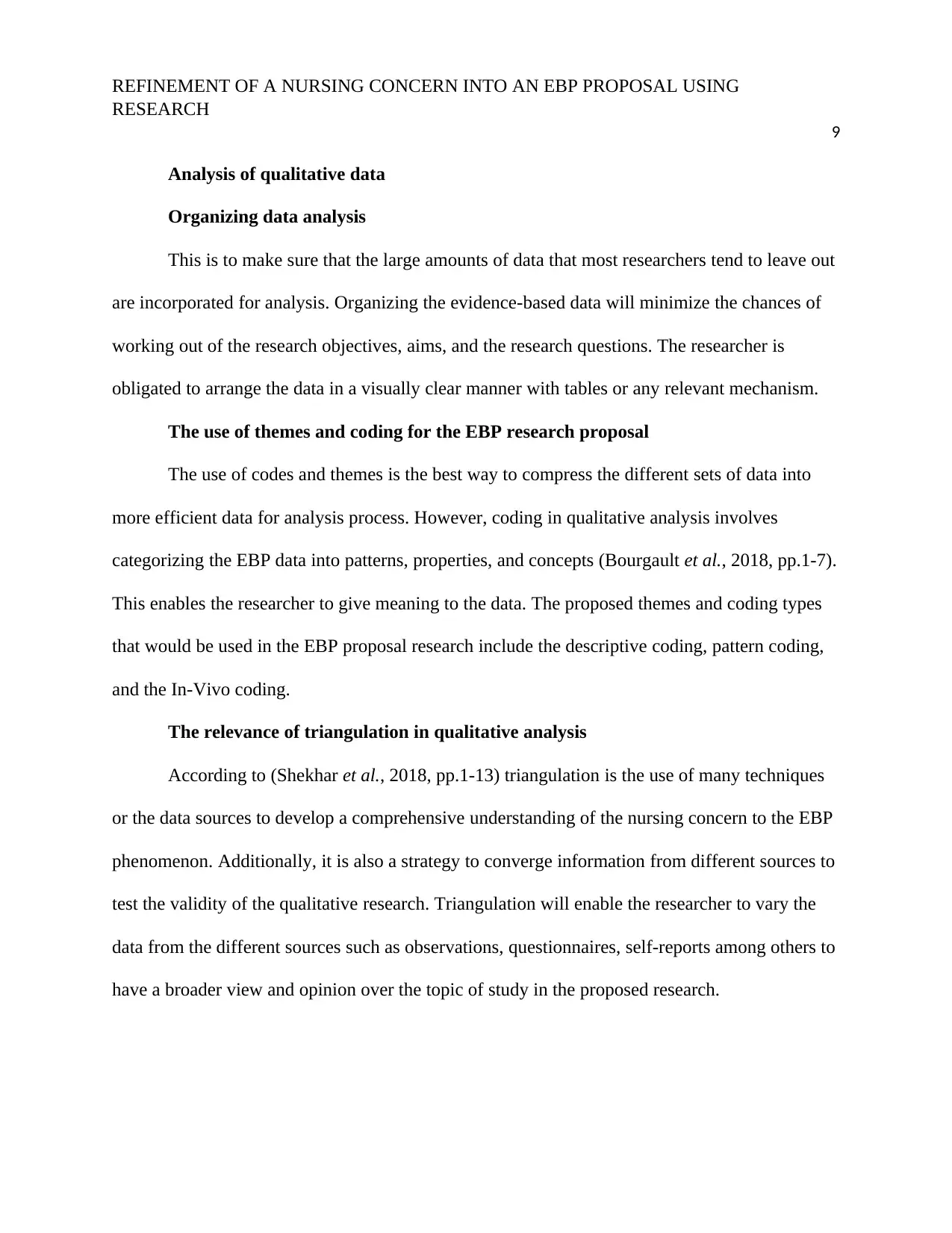
REFINEMENT OF A NURSING CONCERN INTO AN EBP PROPOSAL USING
RESEARCH
9
Analysis of qualitative data
Organizing data analysis
This is to make sure that the large amounts of data that most researchers tend to leave out
are incorporated for analysis. Organizing the evidence-based data will minimize the chances of
working out of the research objectives, aims, and the research questions. The researcher is
obligated to arrange the data in a visually clear manner with tables or any relevant mechanism.
The use of themes and coding for the EBP research proposal
The use of codes and themes is the best way to compress the different sets of data into
more efficient data for analysis process. However, coding in qualitative analysis involves
categorizing the EBP data into patterns, properties, and concepts (Bourgault et al., 2018, pp.1-7).
This enables the researcher to give meaning to the data. The proposed themes and coding types
that would be used in the EBP proposal research include the descriptive coding, pattern coding,
and the In-Vivo coding.
The relevance of triangulation in qualitative analysis
According to (Shekhar et al., 2018, pp.1-13) triangulation is the use of many techniques
or the data sources to develop a comprehensive understanding of the nursing concern to the EBP
phenomenon. Additionally, it is also a strategy to converge information from different sources to
test the validity of the qualitative research. Triangulation will enable the researcher to vary the
data from the different sources such as observations, questionnaires, self-reports among others to
have a broader view and opinion over the topic of study in the proposed research.
RESEARCH
9
Analysis of qualitative data
Organizing data analysis
This is to make sure that the large amounts of data that most researchers tend to leave out
are incorporated for analysis. Organizing the evidence-based data will minimize the chances of
working out of the research objectives, aims, and the research questions. The researcher is
obligated to arrange the data in a visually clear manner with tables or any relevant mechanism.
The use of themes and coding for the EBP research proposal
The use of codes and themes is the best way to compress the different sets of data into
more efficient data for analysis process. However, coding in qualitative analysis involves
categorizing the EBP data into patterns, properties, and concepts (Bourgault et al., 2018, pp.1-7).
This enables the researcher to give meaning to the data. The proposed themes and coding types
that would be used in the EBP proposal research include the descriptive coding, pattern coding,
and the In-Vivo coding.
The relevance of triangulation in qualitative analysis
According to (Shekhar et al., 2018, pp.1-13) triangulation is the use of many techniques
or the data sources to develop a comprehensive understanding of the nursing concern to the EBP
phenomenon. Additionally, it is also a strategy to converge information from different sources to
test the validity of the qualitative research. Triangulation will enable the researcher to vary the
data from the different sources such as observations, questionnaires, self-reports among others to
have a broader view and opinion over the topic of study in the proposed research.
⊘ This is a preview!⊘
Do you want full access?
Subscribe today to unlock all pages.

Trusted by 1+ million students worldwide
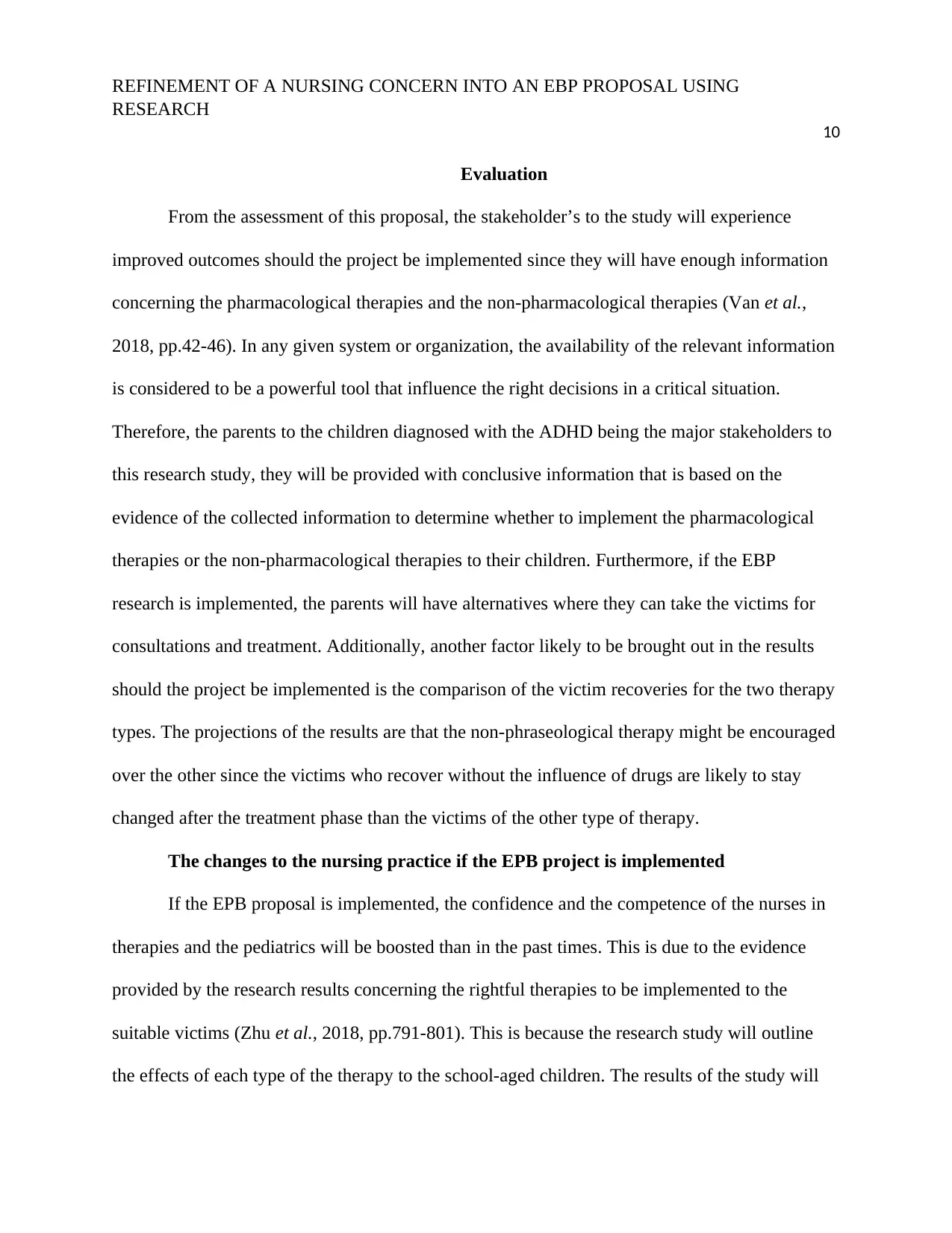
REFINEMENT OF A NURSING CONCERN INTO AN EBP PROPOSAL USING
RESEARCH
10
Evaluation
From the assessment of this proposal, the stakeholder’s to the study will experience
improved outcomes should the project be implemented since they will have enough information
concerning the pharmacological therapies and the non-pharmacological therapies (Van et al.,
2018, pp.42-46). In any given system or organization, the availability of the relevant information
is considered to be a powerful tool that influence the right decisions in a critical situation.
Therefore, the parents to the children diagnosed with the ADHD being the major stakeholders to
this research study, they will be provided with conclusive information that is based on the
evidence of the collected information to determine whether to implement the pharmacological
therapies or the non-pharmacological therapies to their children. Furthermore, if the EBP
research is implemented, the parents will have alternatives where they can take the victims for
consultations and treatment. Additionally, another factor likely to be brought out in the results
should the project be implemented is the comparison of the victim recoveries for the two therapy
types. The projections of the results are that the non-phraseological therapy might be encouraged
over the other since the victims who recover without the influence of drugs are likely to stay
changed after the treatment phase than the victims of the other type of therapy.
The changes to the nursing practice if the EPB project is implemented
If the EPB proposal is implemented, the confidence and the competence of the nurses in
therapies and the pediatrics will be boosted than in the past times. This is due to the evidence
provided by the research results concerning the rightful therapies to be implemented to the
suitable victims (Zhu et al., 2018, pp.791-801). This is because the research study will outline
the effects of each type of the therapy to the school-aged children. The results of the study will
RESEARCH
10
Evaluation
From the assessment of this proposal, the stakeholder’s to the study will experience
improved outcomes should the project be implemented since they will have enough information
concerning the pharmacological therapies and the non-pharmacological therapies (Van et al.,
2018, pp.42-46). In any given system or organization, the availability of the relevant information
is considered to be a powerful tool that influence the right decisions in a critical situation.
Therefore, the parents to the children diagnosed with the ADHD being the major stakeholders to
this research study, they will be provided with conclusive information that is based on the
evidence of the collected information to determine whether to implement the pharmacological
therapies or the non-pharmacological therapies to their children. Furthermore, if the EBP
research is implemented, the parents will have alternatives where they can take the victims for
consultations and treatment. Additionally, another factor likely to be brought out in the results
should the project be implemented is the comparison of the victim recoveries for the two therapy
types. The projections of the results are that the non-phraseological therapy might be encouraged
over the other since the victims who recover without the influence of drugs are likely to stay
changed after the treatment phase than the victims of the other type of therapy.
The changes to the nursing practice if the EPB project is implemented
If the EPB proposal is implemented, the confidence and the competence of the nurses in
therapies and the pediatrics will be boosted than in the past times. This is due to the evidence
provided by the research results concerning the rightful therapies to be implemented to the
suitable victims (Zhu et al., 2018, pp.791-801). This is because the research study will outline
the effects of each type of the therapy to the school-aged children. The results of the study will
Paraphrase This Document
Need a fresh take? Get an instant paraphrase of this document with our AI Paraphraser
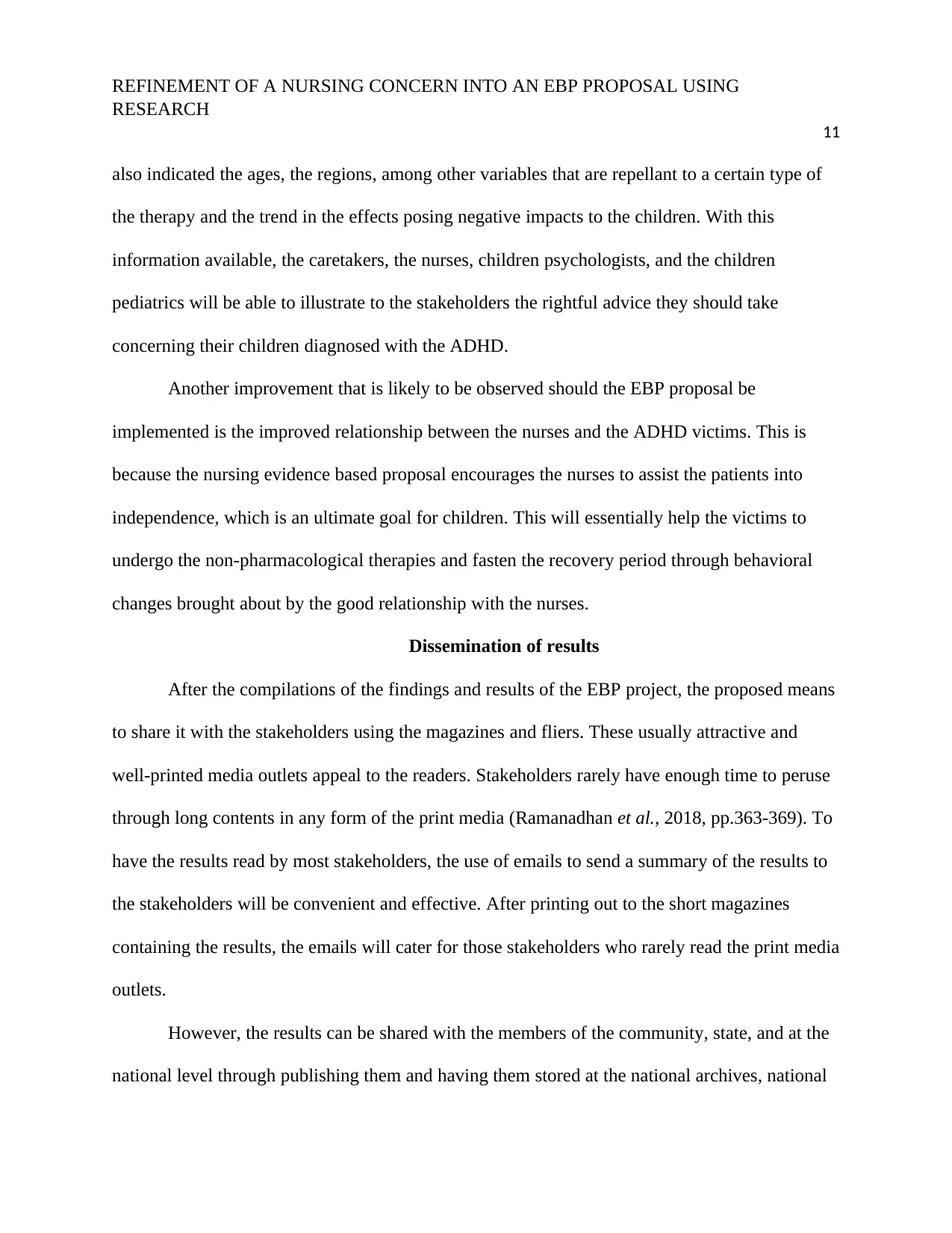
REFINEMENT OF A NURSING CONCERN INTO AN EBP PROPOSAL USING
RESEARCH
11
also indicated the ages, the regions, among other variables that are repellant to a certain type of
the therapy and the trend in the effects posing negative impacts to the children. With this
information available, the caretakers, the nurses, children psychologists, and the children
pediatrics will be able to illustrate to the stakeholders the rightful advice they should take
concerning their children diagnosed with the ADHD.
Another improvement that is likely to be observed should the EBP proposal be
implemented is the improved relationship between the nurses and the ADHD victims. This is
because the nursing evidence based proposal encourages the nurses to assist the patients into
independence, which is an ultimate goal for children. This will essentially help the victims to
undergo the non-pharmacological therapies and fasten the recovery period through behavioral
changes brought about by the good relationship with the nurses.
Dissemination of results
After the compilations of the findings and results of the EBP project, the proposed means
to share it with the stakeholders using the magazines and fliers. These usually attractive and
well-printed media outlets appeal to the readers. Stakeholders rarely have enough time to peruse
through long contents in any form of the print media (Ramanadhan et al., 2018, pp.363-369). To
have the results read by most stakeholders, the use of emails to send a summary of the results to
the stakeholders will be convenient and effective. After printing out to the short magazines
containing the results, the emails will cater for those stakeholders who rarely read the print media
outlets.
However, the results can be shared with the members of the community, state, and at the
national level through publishing them and having them stored at the national archives, national
RESEARCH
11
also indicated the ages, the regions, among other variables that are repellant to a certain type of
the therapy and the trend in the effects posing negative impacts to the children. With this
information available, the caretakers, the nurses, children psychologists, and the children
pediatrics will be able to illustrate to the stakeholders the rightful advice they should take
concerning their children diagnosed with the ADHD.
Another improvement that is likely to be observed should the EBP proposal be
implemented is the improved relationship between the nurses and the ADHD victims. This is
because the nursing evidence based proposal encourages the nurses to assist the patients into
independence, which is an ultimate goal for children. This will essentially help the victims to
undergo the non-pharmacological therapies and fasten the recovery period through behavioral
changes brought about by the good relationship with the nurses.
Dissemination of results
After the compilations of the findings and results of the EBP project, the proposed means
to share it with the stakeholders using the magazines and fliers. These usually attractive and
well-printed media outlets appeal to the readers. Stakeholders rarely have enough time to peruse
through long contents in any form of the print media (Ramanadhan et al., 2018, pp.363-369). To
have the results read by most stakeholders, the use of emails to send a summary of the results to
the stakeholders will be convenient and effective. After printing out to the short magazines
containing the results, the emails will cater for those stakeholders who rarely read the print media
outlets.
However, the results can be shared with the members of the community, state, and at the
national level through publishing them and having them stored at the national archives, national
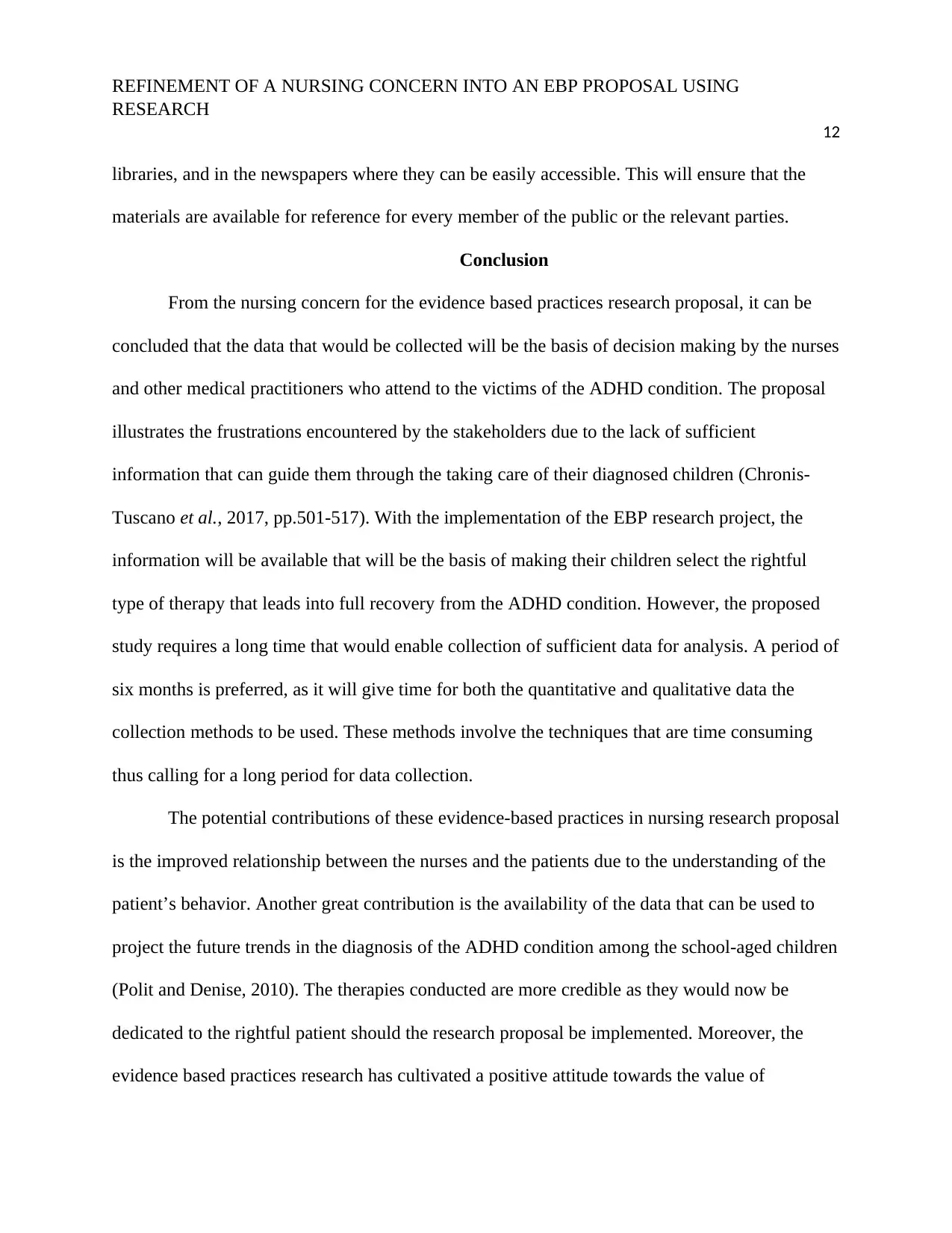
REFINEMENT OF A NURSING CONCERN INTO AN EBP PROPOSAL USING
RESEARCH
12
libraries, and in the newspapers where they can be easily accessible. This will ensure that the
materials are available for reference for every member of the public or the relevant parties.
Conclusion
From the nursing concern for the evidence based practices research proposal, it can be
concluded that the data that would be collected will be the basis of decision making by the nurses
and other medical practitioners who attend to the victims of the ADHD condition. The proposal
illustrates the frustrations encountered by the stakeholders due to the lack of sufficient
information that can guide them through the taking care of their diagnosed children (Chronis-
Tuscano et al., 2017, pp.501-517). With the implementation of the EBP research project, the
information will be available that will be the basis of making their children select the rightful
type of therapy that leads into full recovery from the ADHD condition. However, the proposed
study requires a long time that would enable collection of sufficient data for analysis. A period of
six months is preferred, as it will give time for both the quantitative and qualitative data the
collection methods to be used. These methods involve the techniques that are time consuming
thus calling for a long period for data collection.
The potential contributions of these evidence-based practices in nursing research proposal
is the improved relationship between the nurses and the patients due to the understanding of the
patient’s behavior. Another great contribution is the availability of the data that can be used to
project the future trends in the diagnosis of the ADHD condition among the school-aged children
(Polit and Denise, 2010). The therapies conducted are more credible as they would now be
dedicated to the rightful patient should the research proposal be implemented. Moreover, the
evidence based practices research has cultivated a positive attitude towards the value of
RESEARCH
12
libraries, and in the newspapers where they can be easily accessible. This will ensure that the
materials are available for reference for every member of the public or the relevant parties.
Conclusion
From the nursing concern for the evidence based practices research proposal, it can be
concluded that the data that would be collected will be the basis of decision making by the nurses
and other medical practitioners who attend to the victims of the ADHD condition. The proposal
illustrates the frustrations encountered by the stakeholders due to the lack of sufficient
information that can guide them through the taking care of their diagnosed children (Chronis-
Tuscano et al., 2017, pp.501-517). With the implementation of the EBP research project, the
information will be available that will be the basis of making their children select the rightful
type of therapy that leads into full recovery from the ADHD condition. However, the proposed
study requires a long time that would enable collection of sufficient data for analysis. A period of
six months is preferred, as it will give time for both the quantitative and qualitative data the
collection methods to be used. These methods involve the techniques that are time consuming
thus calling for a long period for data collection.
The potential contributions of these evidence-based practices in nursing research proposal
is the improved relationship between the nurses and the patients due to the understanding of the
patient’s behavior. Another great contribution is the availability of the data that can be used to
project the future trends in the diagnosis of the ADHD condition among the school-aged children
(Polit and Denise, 2010). The therapies conducted are more credible as they would now be
dedicated to the rightful patient should the research proposal be implemented. Moreover, the
evidence based practices research has cultivated a positive attitude towards the value of
⊘ This is a preview!⊘
Do you want full access?
Subscribe today to unlock all pages.

Trusted by 1+ million students worldwide
1 out of 18
Related Documents
Your All-in-One AI-Powered Toolkit for Academic Success.
+13062052269
info@desklib.com
Available 24*7 on WhatsApp / Email
![[object Object]](/_next/static/media/star-bottom.7253800d.svg)
Unlock your academic potential
Copyright © 2020–2025 A2Z Services. All Rights Reserved. Developed and managed by ZUCOL.





